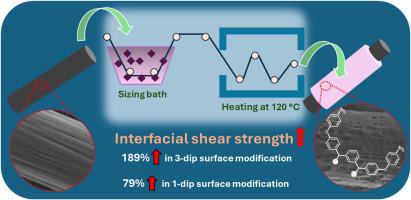On demand thermal surface modification of carbon fiber for improved interfacial shear strength
IF 12.7
1区 材料科学
Q1 ENGINEERING, MULTIDISCIPLINARY
引用次数: 0
Abstract
A thermally triggered, on demand, surface modification method was exploited using carbon fibers (CFs). Bisdiazomethanes undergo thermal activation to generate extremely reactive carbene intermediates, able to react with the CF surface. Herein, the surface modification of continuous CFs is demonstrated by dipping the fibers in a solution of bisdiazomethane at three different concentrations of 1 mmol, 5 mmol, and 10 mmol, followed by air drying and heating at 120 °C. Tensile strength and Young's Modulus values were preserved in the treated fibers, while the interfacial shear strength (IFSS) values showed significant improvement. The highest IFSS improvement was found (189 %) for the fibers dipped in the 5 mmol solution, with significant increases noted for the 1 and 10 mmol modifications, of 54 % and 97 %, respectively. When the thermal modification was repeated with parameters analogous to a sizing application used in CF manufacture (30 s dip, 2-min heating), 74–79 % improvements in IFSS resulted. Hence, this approach can serve as a simple, scalable, and tunable surface modification method for discontinuous CFs that promotes their use in high value applications.

按需对碳纤维表面进行热改性以提高界面剪切强度
我们利用碳纤维(CF)开发了一种热触发、按需表面改性方法。双二噻唑甲烷经过热活化后会生成极具活性的碳烯中间体,并能与碳纤维表面发生反应。在此,通过将纤维浸入 1 毫摩尔、5 毫摩尔和 10 毫摩尔三种不同浓度的双二噻唑甲烷溶液中,然后在 120 °C 下风干和加热,展示了连续碳纤维的表面改性。经处理的纤维的拉伸强度和杨氏模量值保持不变,而界面剪切强度(IFSS)值则有显著改善。浸泡在 5 毫摩尔溶液中的纤维的界面剪切强度提高幅度最大(189%),而经过 1 毫摩尔和 10 毫摩尔改性的纤维的界面剪切强度也有显著提高,分别提高了 54% 和 97%。当重复进行热改性时,参数类似于 CF 生产中使用的上浆应用(浸渍 30 秒,加热 2 分钟),IFSS 提高了 74-79%。因此,这种方法可以作为一种简单、可扩展和可调整的非连续 CF 表面改性方法,促进其在高价值应用中的使用。
本文章由计算机程序翻译,如有差异,请以英文原文为准。
求助全文
约1分钟内获得全文
求助全文
来源期刊

Composites Part B: Engineering
工程技术-材料科学:复合
CiteScore
24.40
自引率
11.50%
发文量
784
审稿时长
21 days
期刊介绍:
Composites Part B: Engineering is a journal that publishes impactful research of high quality on composite materials. This research is supported by fundamental mechanics and materials science and engineering approaches. The targeted research can cover a wide range of length scales, ranging from nano to micro and meso, and even to the full product and structure level. The journal specifically focuses on engineering applications that involve high performance composites. These applications can range from low volume and high cost to high volume and low cost composite development.
The main goal of the journal is to provide a platform for the prompt publication of original and high quality research. The emphasis is on design, development, modeling, validation, and manufacturing of engineering details and concepts. The journal welcomes both basic research papers and proposals for review articles. Authors are encouraged to address challenges across various application areas. These areas include, but are not limited to, aerospace, automotive, and other surface transportation. The journal also covers energy-related applications, with a focus on renewable energy. Other application areas include infrastructure, off-shore and maritime projects, health care technology, and recreational products.
 求助内容:
求助内容: 应助结果提醒方式:
应助结果提醒方式:


